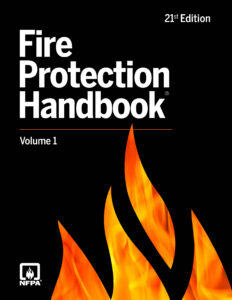01 Mar INDUSTRY LEADER MARK HOPKINS, P.E., FSFPE, AUTHORS INAUGURAL CHAPTER ON CORROSION FOR NEW EDITION OF NATIONAL FIRE PROTECTION ASSOCIATION’S FIRE PROTECTION HANDBOOK
Mark Hopkins, P.E., FSFPE, has written a chapter focused on fire sprinkler corrosion for the new edition of the National Fire Protection Association’s (NFPA) Fire Protection Handbook, 21st Edition. This is a significant development in the handbook’s history because no chapter has ever focused on the topic before.
“I am honored to share my knowledge and expertise on this topic,” Mark said. “I believe it’s a very important chapter to include in the latest edition of the NFPA handbook because corrosion is not a problem that will suddenly disappear on its own.”
Hopkins, a regional director and senior fire protection engineer with TERPconsulting, is a highly regarded expert in the field of fire sprinkler corrosion. He was approached by the NFPA to write the newly added chapter entitled “Corrosion in Fire Sprinkler Systems.” His long-tenured service as a member of NFPA technical committees for NFPA 13 – Standard for the Installation of Sprinkler Systems and NFPA 25 – Standard for the Inspection, Testing, and Maintenance of Water-Based Fire Protection Systems provided him with the necessary expertise and perspective to develop the new chapter.
Mark’s chapter will enlighten readers on the fact that corrosion in sprinkler systems neither has a single cause nor is there a one-size-fits-all approach to its control as a first step for the fire protection industry to manage its effects. The print version of the Fire Protection Handbook will be available on March 3.
“Gaining an understanding of corrosion and understanding why its prevention and mitigation are needed is now more important than ever,” Mark explained. “Reading this chapter is a good start to understanding corrosion and its control, hopefully, while there is no apparent crisis, budget concerns, or scheduling limitations which is when many of us have had to start learning about it.”
With almost 30 years of experience in all aspects of fire protection engineering, Mark has actively leveraged his expertise and leadership abilities to make significant advancements in the arena of fire safety. Before joining TERPconsulting to manage its Baltimore office in 2020, Mark was Vice President of Engineering at the National Fire Sprinkler Association (NFSA) where he oversaw the operations of the engineering department and was the chief technical expert on fire sprinkler systems for the national trade organization.
Mark served as secretary and senior staff representative on multiple NFSA technical committees and councils and participated in 19 technical committees involved in developing National Fire Protection Association (NFPA) codes and standards. He authored Chapter 28 on Systems Acceptance and Chapter 29 on Existing Systems Modifications of the 2019 edition of the NFPA 13 Handbook. Mark currently serves on NFPA 13, 72, 200, and 909/914TCs, and is co-chair of the Wet Collections Task Group (909), chair of the Fire Suppression Task Group (909/914), chair of the Water Supply Task Group (13), and is on numerous other task groups.
Before his role with the NFSA, Mark worked for Hughes Associates, Inc., which later became Jensen Hughes, for 18 years. He designed fire protection systems (including sprinkler systems, water mist systems, water spray systems, fire alarm, and mass notification systems, clean agent systems), conducted hazards assessments, forensic engineering examinations, litigation support, corrosion investigations, and consulted on life safety and building code issues for a variety of occupancies. Mark developed a corrosion investigation protocol for the New York Offices of General Services and Mental Health and co-authored a report for the National Institute of Standards and Technology (NIST) on the performance of the fire suppression systems in the World Trade Center disaster, NCSTAR 1-4B.
To contact Mark, click here.




No Comments